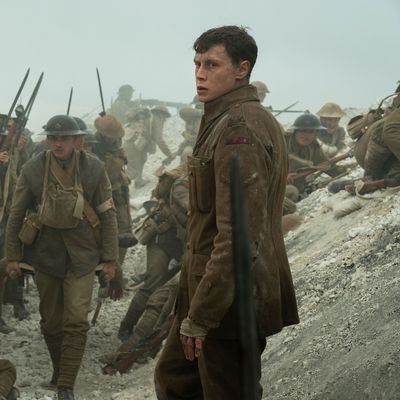
1917 is a war movie made to look as though it were shot in a single continuous take. Or, to be entirely precise, a single take that cuts off while its hero is unconsciousness for a few hours in the middle, which is, I suppose, the body’s answer to editing. It begins by a field in northern France where two young men are dozing, then follows the pair as they wind their way through camp and into trenches that rise up around them, past fellow British soldiers sorting through mail and hanging laundry, or laying wire or crouching in corners, smoking. It’s ostentatiously complicated, dozens of extras engaged in bits of business that are only briefly glimpsed as Schofield (the haunted-eyed George MacKay) and Blake (Dean-Charles Chapman) pass them by. But it’s also a tableau of deliberate mundanity — the best thing the movie does, using its fluid camera to observe the way that even in the midst of shell-shocking combat, life retains qualities of the routine; everyone likes to have clean clothes when they can manage it.
The main characters are just more men in uniform until an assignment transforms them into something else — messengers tasked with warning another battalion that they’re headed into a trap. Blake gets chosen for this urgent mission because his brother is a member of the imperiled unit, and the powers that be believe that will give him extra incentive to get the job done. Schofield gets chosen by Blake to accompany him because they’re friends, though circumstances eventually split him off to travel solo across dangerous territory, desperately trying to reach his goal in time. 1917 is a war movie that also aspires to be a thriller, done on the run and with a ticking clock. But more than either of those things, it’s a bombastic filmmaking stunt, though I’m sure director Sam Mendes doesn’t want to think about it that way.
Mendes, who wrote the script with Krysty Wilson-Cairns, conceived of the look of the film from the start as a kind of blunt-force approach to immersion that would make the audience travel with these characters every step of the way. The single-take approach was, for him, meant to be a means of conveying immediacy and intimacy. But in practice the showy complexity of the undertaking achieves the opposite effect. 1917 can’t help but pull you away from the intense experiences of its constantly on-the-move characters to demand you pay attention to how difficult it was to achieve what’s onscreen while you watch it — to dwell on the mechanics of all of its more intricate moments. The film is a fitting tribute to the incredible skill and patience of director of photography Roger Deakins, who will probably keep winning awards for best cinematography that are actually awards for hardest cinematography.
But it’s less convincing as the homage it seems intended to be to the men who took part in this conflict — one of them Mendes’s grandfather, a veteran of World War I whose stories provided the initial inspiration. “There’s a feeling about this war, that it is in danger of being forgotten,” the director told Variety. For something that strives to bring century-old hostilities back to vivid life, 1917 feels unduly concerned with boring whoever might be watching by lingering on details. To commit to showing someone’s real-time experiences means, well, committing to their real-time experiences, even when that involves trudging through the mud for a while. But the film arranges ways to fling its characters from set piece to set piece, from a sequence in which a character crosses a downed bridge while being shot at from directions unknown to one in which he tumbles over the edge of a waterfall. Cameos from better-known British and Irish talent serve as chapter markers. The artifice of the aesthetic premise overwhelms any of the film’s other intentions.
Formal ambition doesn’t have to equal distance. The obvious comparison for 1917 is Christopher Nolan’s Dunkirk, which was about a different war but which opted for its own high concept by tracking the evacuation of its title through three timelines. The puzzle-box nature of its construction didn’t diminish the events it was portraying or the tangible humanity of the characters navigating them. A less obvious correspondence can be made to Sunset, the László Nemes film from earlier this year set a few years before the conflict that Mendes’s work would go onto depict. Sunset, which tries to show a European society on the verge of tearing itself up, makes use of long-take photography that quietly feels at least as impressive as what 1917 attempts. When the camera tracks protagonist Írisz Leiter (Juli Jakab) out of the shop that used to belong to her family, and out into a teeming city street full of activity that unfolds around her, it’s reminiscent of that first sequence in 1917. The difference is that Mendes’s movie wants you in awe of the scale of what it’s built, while Nemes’s doesn’t want you to think about its world as a creation at all — just a fact.


